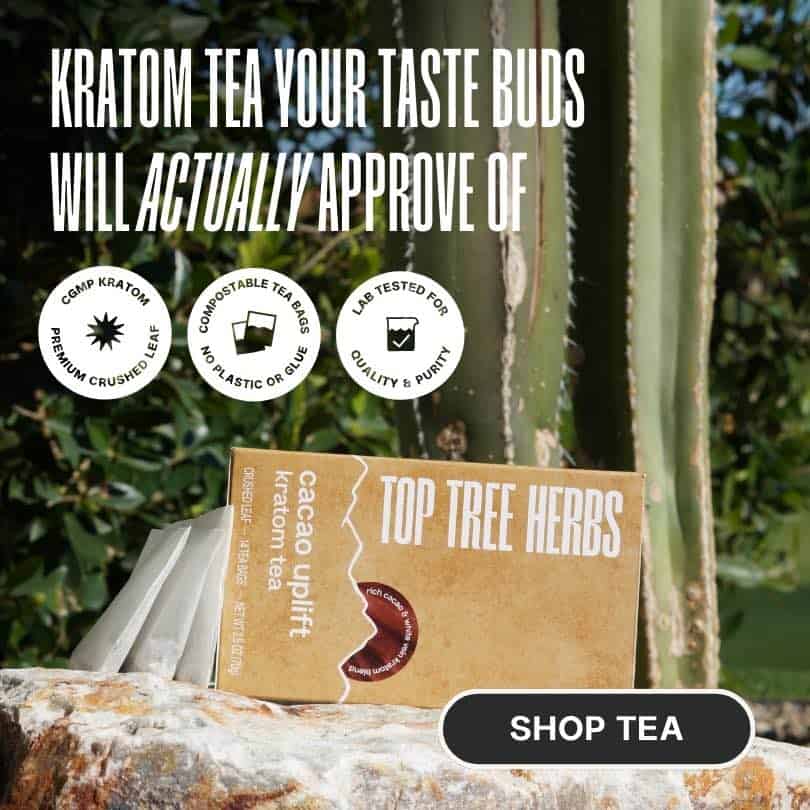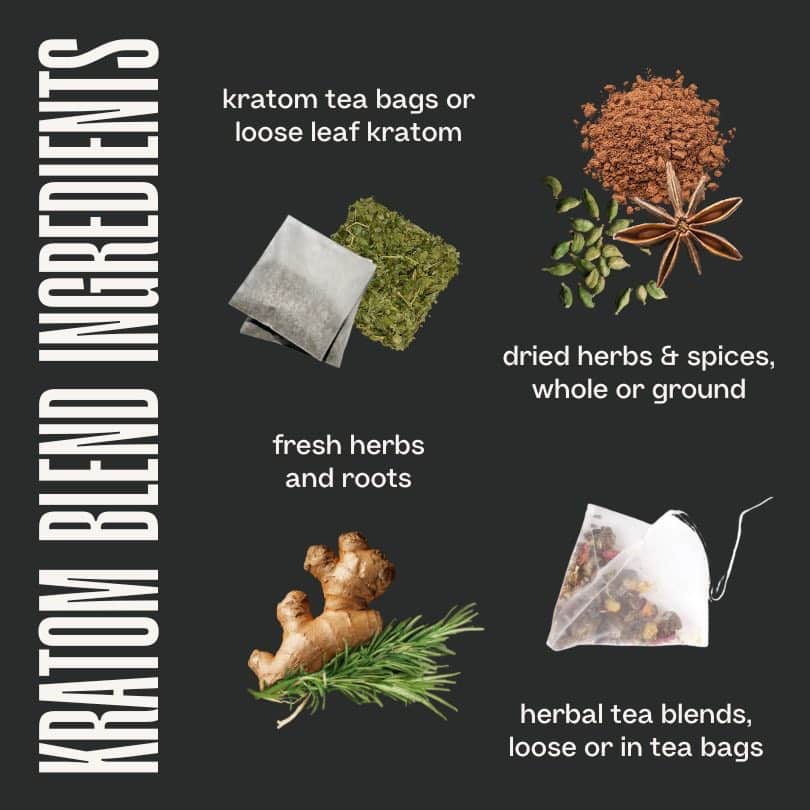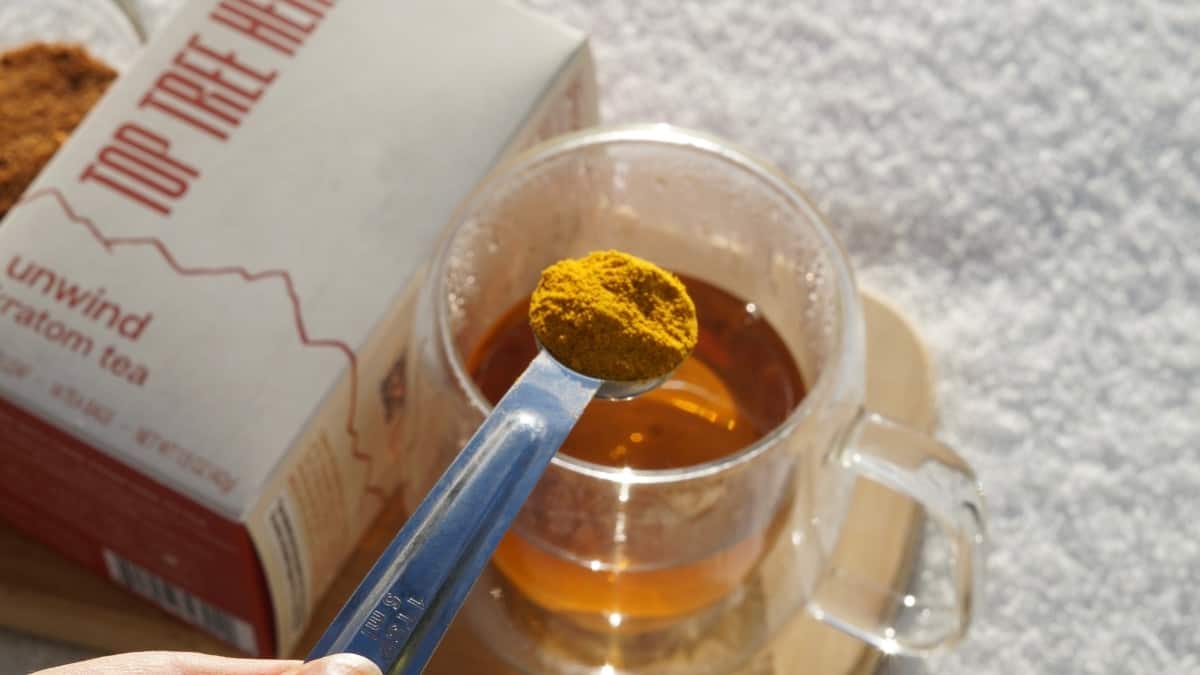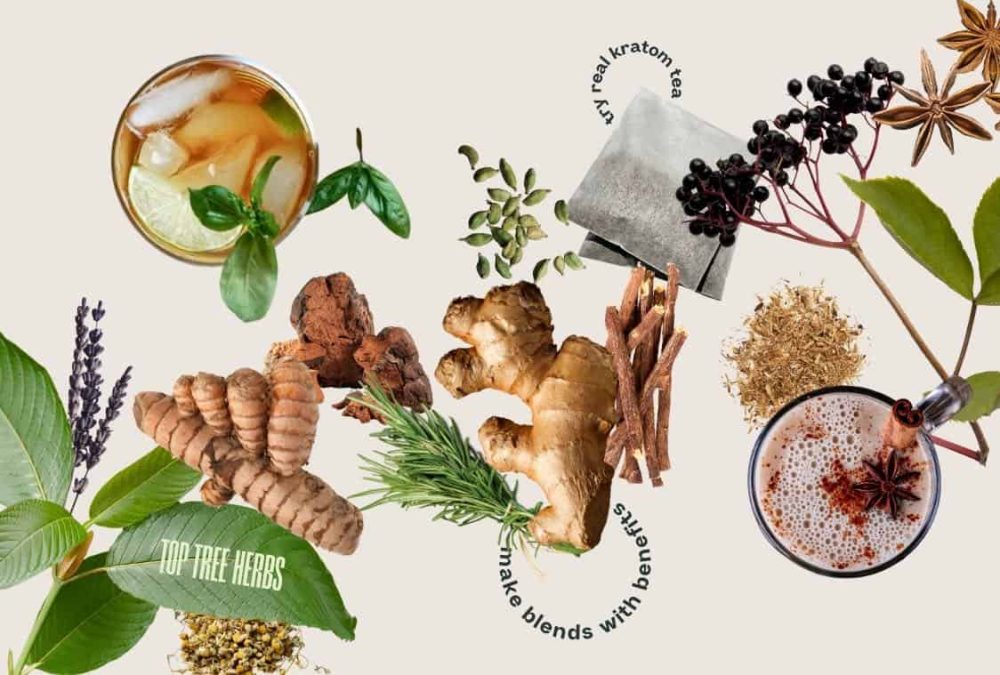Many kratom consumers think of “kratom blends” as combinations of various kratom strains. This is an innovative practice, but not what we’ll be explaining here. We’ve got something even more interesting on deck: how to make the best kratom blends with combinations of functional, flavorful botanicals.
If you were here to learn how to mix kratom strains into a blend, don’t jump ship just yet. We’re here to help support your daily mental and physical challenges, and kratom powder mixes aren’t the only way to do that. Here’s what we’ll cover below:
- What are botanical kratom blends?
- Why blend kratom instead of having kratom alone?
- Store-bought vs. homemade kratom blends
- Recommended blend ingredients
- How to brew your blend
- 4 final tips for making the best blends
- Misconceptions about blending kratom
What Are Botanical Kratom Blends?
Botanical kratom blends are combinations of kratom leaf tea and other plants that provide both function and flavor. Blends can include many types of herbs and spices for these purposes. There are a few ways to brew blends depending upon which ingredients you choose.
Related: Strapped for time? Shop pre-made botanical kratom blends with function & flavor.
Below, we’ll guide you through how to make a range of kratom blends at home. We’ll also outline common misconceptions about botanical kratom blends.
If you haven’t yet covered the basics of how to make kratom tea or what kratom tea is good for, we recommend starting there and learning how to make kratom blends afterwards.

An Important Note on Conscious Consumption and Safety
All of the blends listed below have been tried and tested numerous times by Top Tree staff. However, these combinations haven’t undergone scientific testing or clinical trials. The statements below haven’t been evaluated by the Food and Drug Administration. Kratom is not intended to diagnose, treat, cure, or prevent any disease.
Some botanicals or combinations of botanicals may not be right for you. Make sure to speak with a healthcare professional before you add kratom or other botanicals to your wellness routine. This is especially important if you have any health concerns, take medications, or are nursing or pregnant.
Why Blend Kratom Instead of Having Kratom Alone?
The best kratom blends provide synergistic effects while also tempting your taste buds. This is pretty important because, let’s face it, plainly brewed kratom tea with crushed-leaf can taste bitter to many people. Here’s the complete breakdown of why blends are better than regular kratom:
1. Added Mind & Body Benefits
Other ingredients can add to or enhance the benefits you get from your kratom tea. These benefits range from digestion and immune support to energy and rest.
Kratom has a broad range of effects, but it isn’t a cure for anything, let alone a panacea. It’s important to realize that kratom tea is just one aspect of a holistic wellness practice.
2. Serving Size Reset
After prolonged consumption of particular herbs and compounds, you may find that you need larger amounts to feel the same effects. By utilizing other ingredients, you can potentially reduce the amount of kratom—or the secondary ingredients—you need to consume to get their benefits.
3. Mitigated Negative Effects
Surveys of kratom tea drinkers show that they typically experience less stomach upset than people who consume kratom powder. However, it isn’t impossible to experience this or other unintended effects from consuming or over-consuming tea.
Consuming functional herbs like ginger or mint with your kratom could help prevent these issues. Note, though, that if you’re experiencing negative effects, you should first contact a healthcare professional before trying blends to solve the problem.
4. Improved Flavor
Last—but certainly not least—blends can taste far better than kratom alone. Kratom leaves are very bitter. If you’ve ever done the kratom toss and wash method or made a slurry, you’ll know what we mean. Kratom leaf tea tastes much better, but it is still pretty astringent.
If you don’t like drinking bitter teas, brewing your kratom with other flavorful botanicals can make a huge difference in your experience and enjoyment.
Store-Bought vs. Homemade Kratom Blends
You can blend kratom yourself or buy premade blends from various kratom companies. Top Tree makes pre-packed botanical kratom blends in tea bags. Plus, a number of other kratom companies make kratom products mixed with other plants. Here are the pros and cons of store-bought vs. homemade kratom blends:
Store-Bought Kratom Blend Pros & Cons:
- Convenient and easy to use
- Set ratio of kratom to other plants, can’t be customized
- Typically more expensive (with the exception of pre-packed kratom blend tea bags)
- Some companies’ combinations of herbs may not be scientifically tested for safety
Homemade Kratom Blend Pros & Cons:
- Customizable combinations of botanicals to meet your exact needs
- Adjustable ratio of kratom to other plants so you get personalized serving sizes of each
- Requires a bit more preparation and effort
- Typically (but not always) less expensive
Recommended Kratom Blend Ingredients
When it comes to making kratom tea blends, there’s no one-size-fits-all solution. Everyone has different preferences and needs based on their individual physiology, daily activity, and other circumstances.

Here are a few blends with one or multiple additional ingredients that we recommend trying to enhance your kratom experience:
- Turmeric and black pepper: Fresh and ground turmeric root contains curcumin, which has a number of health benefits. Piperine, which is found in black pepper, enhances curcumin’s bioavailability. So you can add a dash of pepper to your blends that contain turmeric.
- Ginger: Known for its stomach-settling qualities, freshly sliced ginger root can be a great addition to a kratom blend. It’s especially good for those who experience digestive issues from kratom alone.
- Chamomile, lemon balm, or valerian root: Known for their calming effects, chamomile, lemon balm, and valerian root (in moderation) can each be mixed with kratom to enhance its soothing effects—that’s why chamomile is a staple in Top Tree’s relaxing red vein chai kratom blend.
- Slippery elm and marshmallow root: These are two of the main ingredients in Traditional Medicinals’ Throat Coat™ tea. They both have a high mucilage content. Thus, they can be blended with kratom when you’re feeling under the weather. Remember, though, this blend should not be used as a treatment, prevention, or cure for any disease.
- Peppermint: Peppermint tea has been shown in some studies to improve long-term memory and speed of memory. It has an “arousing” effect. Mint is great when blended with white vein kratom tea as a coffee alternative or a kratom pre-workout brew.
- Cardamom and anise: These spices, which both have a range of proposed mild health benefits, taste incredible with kratom. You can make a kratom drink that tastes like Thai iced tea but is much more functional than the sugar-laden restaurant version. Chill your spiced kratom tea, then top it with a splash of coconut milk or low-sugar non-dairy creamer.
- Green tea, moringa, or ginseng tea: These common teas are renowned for their antioxidant contents. Be mindful when combining them with kratom. The energizing properties of each may be overwhelming in combination.
- Stevia, rooibos, or honeybush: Try blending kratom with herbs that have natural sweetness to lessen the need for added sugars. Rooibos is featured in Top Tree’s tulsi rooibos peach & mango blend as well as its chai blend.
Other options include functional mushrooms, kava root, cinnamon, thyme, rosemary, citrus fruits, elderberry, chicory, cacao, lavender flowers, rosehips, cloves, pink peppercorns, nutmeg, basil, echinacea, ashwagandha… the list goes on.
We recommend learning about herbalism fundamentals and experimenting with a few different ingredients (and ratios of ingredients) to find out what works best for you. You can also try out one of these specialty kratom tea recipes:
- Relaxing kratom golden milk
- Easy iced kratom chai
- Bright tulsi and sage kratom iced tea
- Cocoa mint kratom tea recipe
- Soothing ginger and vanilla kratom tea

How to Brew Your Blend
Roll up your sleeves! It’s time to learn how to make the best kratom tea blends at home.
1. Choose Your Kratom Base
We recommend using white vein kratom tea as a base for energizing blends. Typically, red vein kratom tea is the best base for relaxing blends. Try green for balancing and focusing kratom blends. Each person’s experience will be different, though, so choose what works for you in each circumstance.
2. Select Your Botanicals
Based on the benefits you’re looking for, select a few botanicals to mix with your kratom. It’s best to start with one or two and then adjust from there. You can use any of the following:
- Fresh herbs and roots
- Whole or ground dried herbs, roots, and spices
- Herbal tea bags
- Loose leaf herbal tea
- Herbal extracts and tinctures
3. Measure and Mix
We recommend beginning with a ratio of about 60% kratom to 40% other botanicals. For example, in Top Tree’s pre-made blends, the ratio is 3g of kratom leaf to 2g of other herbs and spices.
Adjust your ratio and serving size according to ingredient strength, taste preferences, and desired effects. Use a digital scale for the most precise measurements.
4. Brew your Kratom Blend
Kratom requires a long, hot steep to effectively extract the active compounds in the leaves. Using any woody stems, bark, or other tough plant materials? You can brew it with the kratom tea bags for the full steep time.
For more delicate ingredients like leaves or flowers, consider adding them towards the end of the brewing process or after the kratom tea has cooled slightly. That way, you won’t destroy delicate active or aromatic compounds. Plus, steeping the certain ingredients for longer than needed can bring out bitter compounds like tannins that you want to leave out of your brew.
Need more advice on how to brew different types of botanicals? You can learn the basics of herbal tea infusions and decoctions here.
5. Record Your Recipe
Once you find a blend you like, make sure to write down the recipe for future reference.
4 Final Tips for Making the Best Kratom Blends
1. Add One New Ingredient at a Time
We recommend adding just one new herb or spice to your kratom tea at a time. This will allow you to get a better idea of how each ingredient affects you. It’ll also help you identify any sensitivities to ingredients you might have.
If you add five new herbs to your kratom tea at once, it’s much harder to tell which herb is providing which effects. Keep in mind, some herbs and spices work best in combination or after a few uses. Most don’t provide noticeable psychoactive effects.
2. Less is More
If you’re new to kratom tea, the best practice is to start with 1 tea bag (3 grams) of kratom and sip your tea slowly. Then, if one tea bag is too light and doesn’t provide the effects you’re looking for, you can always make another cup.
The same is true for the other botanicals in your blend. Do your research to ensure you’re using the proper amount. Keep in mind that the amount of a botanical you need may be smaller when mixed with kratom.
3. Know Your Ingredients & Prioritize Quality
Each herb or added ingredient has its own unique properties. Some require boiling and longer brewing times, others require lower heat and short steeps, etc. To get the best benefits from each, you may need to add them to your pot or thermos at different times.
Moreover, to get the best benefits, you need to start with the highest-quality ingredients. Buy both your kratom and botanical add-ins from reputable vendors who lab-test for heavy metals and microbiological contaminants.
4. Lean into the Fun
This process is all about experimenting and creating something that you enjoy. The stakes are usually low, and if you make a brew you don’t love, you can simply try again. Creating kratom blends is an opportunity to play and have fun.
Misconceptions About Blending Kratom
One misconception is that homemade blends are inherently less safe than store-bought options. However, as long as you’re sourcing your ingredients from reputable suppliers and consulting with healthcare professionals as needed, making your own kratom blends can be both safe and rewarding.
Related: 5 Things You Need to Consider to Source the Highest Quality Kratom
Another misconception is that adding botanicals to kratom will dilute its effects, but this isn’t necessarily true. If chosen wisely, the additional botanicals can enhance the kratom experience by targeting specific needs or preferences.
Cheers to Better Blend Brewing
Remember, the goal of a botanical kratom blend is to personalize your experience. Whether you’re looking for enhanced flavor, additional health benefits, or both, creating your own blends allows you to tailor your kratom intake to your personal wellness goals.
Always start with small amounts when trying new blends. Give your body time to adjust to the combined effects of kratom and other botanicals.
Want to learn more ways to easily brew effective, strong tea with kratom? Check out these classic kratom brew guides to get the most out of every bag of tea. Cheers!





